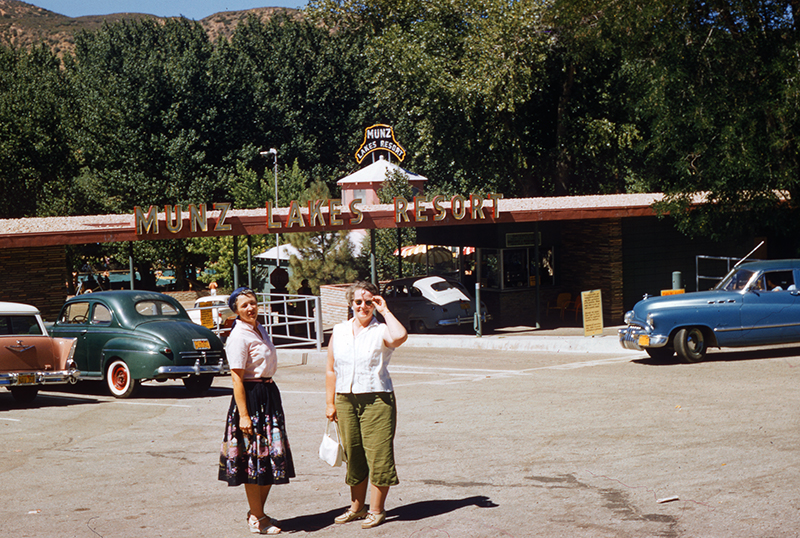Munz Lakes Resort
Lake Hughes Area

Click image to enlarge
| Download archival scan
Two unidentified women stand outside the entrance to Munz Lakes Resort on Elizabeth Lake Road, circa 1960. (The 6-character, black-on-gold California license plates were issued from 1956-1963.) Kodachrome transparency (slide film). Eastman Kodak introduced Kodachrome in 1935.
About Munz Lakes. The Munz Lakes Resort was established at what is now 17000 Elizabeth Lake Road, between Lake Hughes on the west and Lake Elizabeth on the east, by the heirs of John Munz, a Swiss farmer and merchant who settled on the property in 1898. John Munz (b. 1850) immigrated in 1878 to Illinois where he met his Swiss-born bride, Amalia Tischauser (b. 1860), and set up a farm. In the 1890s they relocated to the German/Swiss Lutheran colony of Palmenthal, aka Palendale, aka Palmdale, Calif., where they operated the Munz General Store. The couple had eight children before 1898 when Amalia died in childbirth. Faced with his wife's death as well as a drought that compelled many of his customers to abandon the settlement, John Munz traded his store in 1898 for a 160-acre homestead at Elizabeth Lake and started over. John and his children established the region's first big turkey ranch on the property. John became a justice of the peace, and one of his children was appointed Elizabeth Lake postmaster in 1914, running the post office inside the family home. Sometime before 1934 — and probably after John's death in 1925 — his children dug and filled the 6.5-acre, 5-foot-deep Munz Lake. (Unlike the 123.2-acre Lake Elizabeth and the 21.4-acre Lake Hughes, Munz is man-made. Its water comes from wells, rain and runoff, partially from Lake Elizabeth, and it discharges into Lake Hughes. As for Munz "Lake" vs. "Lakes": While it might surface in multiple pools, regulatory agencies consider it a single water body.) It was around this time that John's descendants established the Munz Lakes Resort. The lake was apparently expanded to 26 acres. According to L.A. County Assessor records, one building that still stands on the property was erected in 1950. The signature building, the Locust Tree Grill — located across the street from L.A. County Fire Station 78 — undoubtedly predated the 1950 structure, but it was torn down in the early 2000s when actor and philanthropist Paul Newman purchased the property for The Painted Turtle, a nonprofit camp that provides focused activities for chronically ill children. The initial camp buildings were erected in 2003, and the camp opened in 2004. The property was heavily impacted on the evening of June 1, 2013, when the Powerhouse Fire ravaged the lake communities. The Painted Turtle's many buildings narrowly escaped the flames — only a barn and two sheds were lost — but the grounds were devastated and the structures sustained heavy smoke damage. The organization had to cancel its 2013 summer program schedule and started raising money for restoration.
LW3678: 9600 dpi jpeg from original color transparency purchased 2019 by Leon Worden.
|
